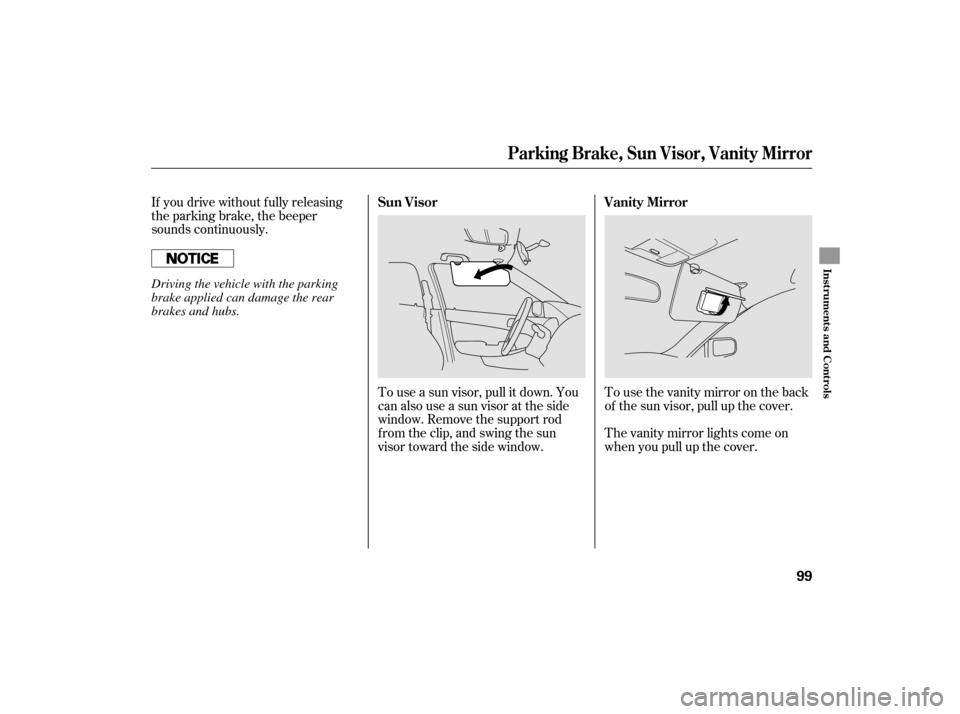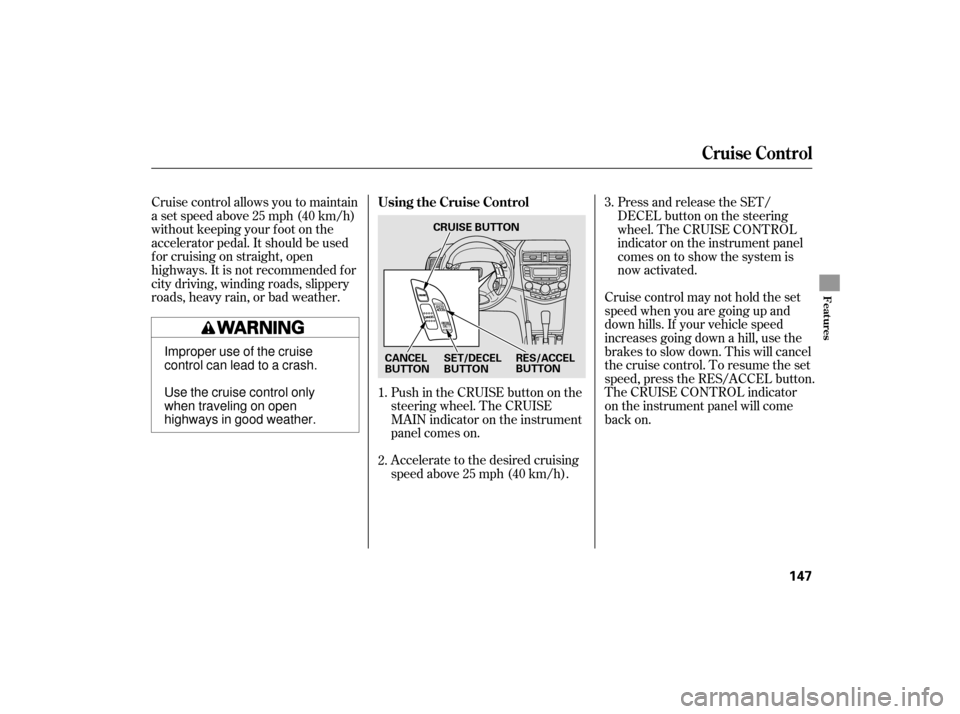2007 HONDA ACCORD HYBRID brakes
[x] Cancel search: brakesPage 63 of 287

The instrument panel has many
indicators to give you important
inf ormation about your vehicle.
The engine can be severely damaged
if this indicator f lashes or stays on
when the engine is running. For
more information, see page .
If this indicator comes on when the
engine is running, the battery is not
being charged. For more inf ormation,
see page .
See page .This indicator has two f unctions:
This indicator comes on when you
turn the ignition switch to the ON
(II) position. It reminds you and your
passengers to f asten your seat belts.
A beeper also sounds if you have not
f astened your seat belt.
If you turn the ignition switch to the
ON (II) position bef ore f astening
your seat belt, the beeper sounds
and the indicator f lashes. If you do
notfastenyourseatbeltbeforethe
beeper stops, the indicator stops
f lashing but remains on.
Itcomesonwhenyouturnthe
ignition switch to the ON (II)
position. It is a reminder to check
the parking brake. A beeper
sounds if you drive with the
parking brake not f ully released.
Driving with the parking brake not
fully released can damage the
brakes and tires.
If it remains lit af ter you f ully
release the parking brake while
the engine is running, or if it
comes on while driving, there
could be a problem with the brake
system. For more inf ormation, see
page .
1.
2.
245
245 246 247
Instrument Panel Indicators
L ow Oil Pressure
Indicator
Charging System
Indicator
Malf unction Indicator
LampParking Brake and Brake
System Indicator
Seat Belt Reminder
Indicator
60
U.S. Canada
06/08/08 14:26:02 31SDR620_065
Page 64 of 287

If your f ront passenger does not
f asten their seat belt, the indicator
comes on about 6 seconds af ter the
ignition switch is turned to the ON
(II) position.
If either of you do not f asten your
seat belt while driving, the beeper
will sound and the indicator will f lash
again at regular intervals. For more
inf ormation, see page .This indicator normally comes on f or
a f ew seconds when you turn the
ignition switch to the ON (II)
position, and when the ignition
switch is turned to the START (III)
position. If it comes on at any other
time, there is a problem with the
ABS. If this happens, have your
vehicle checked at a dealer. With
this on, your vehicle still has normal
braking ability but no anti-lock
brakes. For more inf ormation, see
page . This indicator comes on when you
turn the ignition switch to the ON
(II) position. If it comes on at any
other time, it indicates that the
passenger’s side airbag has
automatically shut off. For more
inf ormation, see page .
This indicator comes on brief ly when
you turn the ignition switch to the
ON (II) position. If it comes on at
any other time, it indicates a
potential problem with your f ront
airbags. This indicator will also alert
you to a potential problem with your
side airbags, passenger’s side airbag
automatic cutoff system, side curtain
airbags, automatic seat belt
tensioners, driver’s seat position
sensor, or the f ront passenger’s
weight sensors. For more
inf ormation, see page .
20
3132
181
Instrument Panel Indicators
Supplemental Restraint
System Indicator Anti-lock Brake System
(A BS) IndicatorSide Airbag Of f
Indicator
Inst rument s and Cont rols
61
U.S. Canada
06/08/08 14:26:13 31SDR620_066
Page 102 of 287

Thevanitymirrorlightscomeon
when you pull up the cover. Tousethevanitymirrorontheback
of the sun visor, pull up the cover.
If you drive without f ully releasing
the parking brake, the beeper
sounds continuously.
To use a sun visor, pull it down. You
can also use a sun visor at the side
window. Remove the support rod
f rom the clip, and swing the sun
visor toward the side window.Vanity Mirror
Sun Visor
Parking Brake, Sun Visor, Vanity Mirror
Inst rument s and Cont rols
99
Driving the vehicle with the parking
brake applied can damage the rear
brakes and hubs.
06/08/08 14:33:00 31SDR620_104
Page 150 of 287

Accelerate to the desired cruising
speedabove25mph(40km/h).
Cruise control allows you to maintain
asetspeedabove25mph(40km/h)
without keeping your f oot on the
accelerator pedal. It should be used
f or cruising on straight, open
highways. It is not recommended f or
city driving, winding roads, slippery
roads, heavy rain, or bad weather. Cruise control may not hold the set
speed when you are going up and
down hills. If your vehicle speed
increases going down a hill, use the
brakes to slow down. This will cancel
thecruisecontrol.Toresumetheset
speed, press the RES/ACCEL button.
The CRUISE CONTROL indicator
on the instrument panel will come
back on.
Push in the CRUISE button on the
steering wheel. The CRUISE
MAIN indicator on the instrument
panel comes on. Press and release the SET/
DECELbuttononthesteering
wheel. The CRUISE CONTROL
indicator on the instrument panel
comes on to show the system is
now activated.
1.
2. 3.
Using the Cruise Control
Cruise Control
Features
147
CANCEL
BUTTON RES/ACCEL
BUTTON
CRUISE BUTTON
SET/DECEL
BUTTONImproper use of the cruise
control can lead to a crash.
Use the cruise control only
when traveling on open
highways in good weather.
06/08/08 14:40:32 31SDR620_152
Page 159 of 287

Help assure your vehicle’s f uture
reliability and perf ormance by paying
extra attention to how you drive
during the f irst 600 miles (1,000 km).
During this period:Avoid full-throttle starts and rapid
acceleration.
Do not change the oil until the
scheduled maintenance time.
Avoidhardbrakingforthefirst
200 miles (300 km).
Do not tow a trailer.
You should also f ollow these
recommendations with an
overhauled or exchanged engine, or
when the brakes are replaced. Your vehicle is designed to operate
on unleaded gasoline with a pump
octane number of 87 or higher. Use
of a lower octane gasoline can cause
a persistent, heavy metallic rapping
noise that can lead to engine damage.
We recommend quality gasoline
containing detergent additives that
help prevent f uel system and engine
deposits.
In addition, in order to maintain good
perf ormance, f uel economy, and
emissions control, we strongly
recommend, in areas where it is
available, the use of gasoline that
does NOT contain manganese-based
f uel additives such as MMT.
Some gasoline today is blended with
oxygenates such as ethanol or
MTBE. Your vehicle is designed to
operate on oxygenated gasoline
containing up to 10 % ethanol by
volume and up to 15 % MTBE by
volume. Do not use gasoline
containing methanol.
If you notice any undesirable
operating symptoms, try another
service station or switch to another
brand of gasoline.
For f urther important f uel-related
inf ormation, please ref er to your
.
Use of gasoline with these additives
may adversely af f ect perf ormance,
and cause the malfunction indicator
lamp on your instrument panel to
come on. If this happens, contact your dealer f or service.
Break-in Period, Fuel Recommendation
Break-in Period
Fuel Recommendation
Quick Start Guide
156
06/08/08 14:42:00 31SDR620_161
Page 165 of 287

Bef ore installing any accessory:Make sure the accessory does not
obscure any lights, or interf ere
with proper vehicle operation or
perf ormance.
When properly installed, cellular
phones, alarms, two-way radios, and
low-powered audio systems should
not interf ere with your vehicle’s
computer controlled systems, such
as your airbags and anti-lock brakes.
Modif ying your vehicle, or installing
some non-Honda accessories, can
make your vehicle unsaf e. Bef ore
you make any modif ications or add
anyaccessories,besuretoreadthe
f ollowing inf ormation.
Your dealer has Honda accessories
that allow you to personalize your
vehicle. These accessories have
been designed and approved f or your
vehicle, and are covered by warranty.
Although non-Honda accessories
may f it on your vehicle, they may not
meet f actory specif ications, and
could adversely af f ect your vehicle’s
handling and stability.
Do not install accessories on the
side pillars or across the rear
windows. In these areas,
accessories may interf ere with
proper operation of the side
curtain airbags. Bef ore installing any electronic
accessory, have the installer
contact your dealer for assistance.
If possible, have your dealer
inspect the f inal installation. Be sure electronic accessories do
not overload electrical circuits
(see page ) or interf ere with
the proper operation of your
vehicle.249
A ccessories
A ccessories and Modif ications
162
Improper accessories or
modifications can affect your
vehicle’s handling, stability, and
performance, and cause a
crash in which you can be hurt
or killed.
Follow all instructions in this
owner’s manual regarding
accessories and modifications.
06/08/08 14:43:00 31SDR620_167
Page 166 of 287

Removing parts f rom your vehicle,
or replacing components with
af termarket components could
seriously af f ect your vehicle’s
handling, stability, and reliability.Larger or smaller wheels and tires
can interf ere with the operation of
your vehicle’s anti-lock brakes and
other systems.
If you plan to modif y your vehicle,
consult your dealer. Modif ying your steering wheel or
any other part of your vehicle’s
safety features can make the
systems inef f ective.
Lowering the vehicle with a non-
Honda suspension kit that
signif icantly reduces ground
clearance can allow the
undercarriage to hit speed bumps
or other raised objects, which
could cause the airbags to deploy.
Raising your vehicle with a
non-Honda suspension kit can
af f ect the handling and stability.
Non-Honda wheels can cause
excessive stress on suspension
components.
Herearesomeexamples: Modif ying Your Vehicle
A ccessories and Modif ications
Bef ore Driving
163
06/08/08 14:43:09 31SDR620_168
Page 172 of 287

This section gives you tips on
starting the engine under various
conditions, and how to operate the
automatic transmission. It also
includes important inf ormation on
parking your vehicle, the braking
system, the vehicle stability assist
(VSA) system, and f acts you need if
you are planning to tow a trailer.
........................Preparing to Drive . 170
.......................Starting the Engine . 171
..............Automatic Transmission . 172
Shif t Lever Position
...............................Indicators . 172
.......................................Shif ting . 172
..............Engine Speed Limiter . 174
....................Shif t Lock Release . 175
............................Auto Idle Stop . 177
...........Auto Idle Stop Indicator . 178
...........................................Parking . 179
.............................Braking System . 180
...........Braking System Design . 180
.....Brake Pad Wear Indicators . 180
...............Anti-lock Brakes (ABS) . 181
............................ABS Indicator . 181
Vehicle Stability Assist (VSA)
....................................System . 183
.........VSA Activation Indicator . 183
..............VSA System Indicator . 183
.........................VSA Of f Switch . 184
...................VSA and Tire Sizes . 184
...........................Towing a Trailer . 185
Driving
Driving
169
06/08/08 14:43:58 31SDR620_174